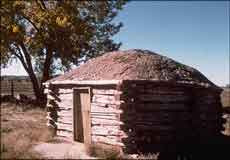People of the Legends
Indigenous People of North America - Navajo
Life at Home - Family Life
Getting married
 Years ago when young Navajo people got married, the husband would move in with his wife at her parents’ home because there weren’t enough houses.
Years ago when young Navajo people got married, the husband would move in with his wife at her parents’ home because there weren’t enough houses.
Parents might also chose marriage partners for their children. This was a good way to make an alliance with another family.
Today young people choose who they will marry, and more houses are available so they can live on their own. But many live near the wife’s parents so the children can spend time with their maternal grandmother. Traditionally a large space is left between the couple’s house and the parent’s house. This is because a man is not supposed to look at or speak to his mother-in-law.
Birth of a child
 When a child is born, a Blessing Way ceremony is usually held in the home.
When a child is born, a Blessing Way ceremony is usually held in the home.
The first person outside the immediate family who makes the child laugh holds a party for the child. This is very special for that person.
Raising animals
 Families living in rural areas may keep sheep and angora goats, and horses and cattle if there is enough feed for them.
Families living in rural areas may keep sheep and angora goats, and horses and cattle if there is enough feed for them.
Llamas are becoming popular – they are more aggressive than sheep and goats if they are attacked by coyotes.
The sheep and goats are moved into a corral at night to keep them away from coyotes and wolves.


Good fortune and health
 Traditionally the Navajo believe that if people live in harmony with the land, nature and each other, illness and bad luck will not happen. This harmony with the universe is called hozho.
Traditionally the Navajo believe that if people live in harmony with the land, nature and each other, illness and bad luck will not happen. This harmony with the universe is called hozho.
Rules or taboos, have to be followed including not touching a tree that has been struck by lightening, and not combing your hair at night.
If someone gets sick, this is a sign of disharmony. They may have broken a taboo, come into contact with a ghost or had a witch’s spell cast on them.
 A sick person may visit a stargazer or hand trembler - usually a woman, who will diagnose their illness. She concentrates on their body, prays and sprinkles sacred pollen – and her hand trembles and points to the body area that is the source of the illness.
A sick person may visit a stargazer or hand trembler - usually a woman, who will diagnose their illness. She concentrates on their body, prays and sprinkles sacred pollen – and her hand trembles and points to the body area that is the source of the illness.
The stargazer then decides which healing ceremony is needed. A medicine person or singer is called, who knows the ceremony and chants, and the sick person or their family prepares for the ceremony. Ceremonies take time and money.
 The medicine person and assistants have to be paid - with food, jewellery, rugs, blankets, animals or cash.
The medicine person and assistants have to be paid - with food, jewellery, rugs, blankets, animals or cash.
Friends and other family members come to help with the chant and must be fed and housed also.
Hospitals on the Navajo Nation have special rooms where healing ceremonies are carried out. People can choose to have traditional healing and modern medical treatment.




